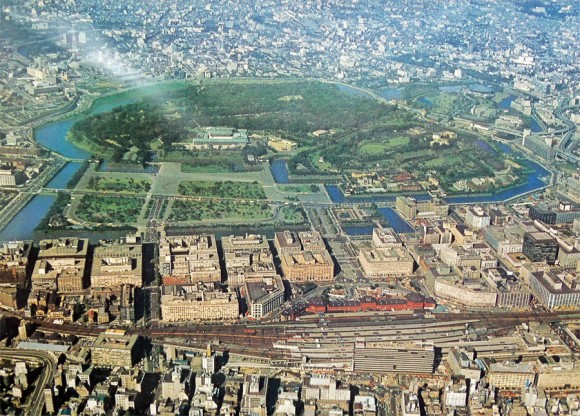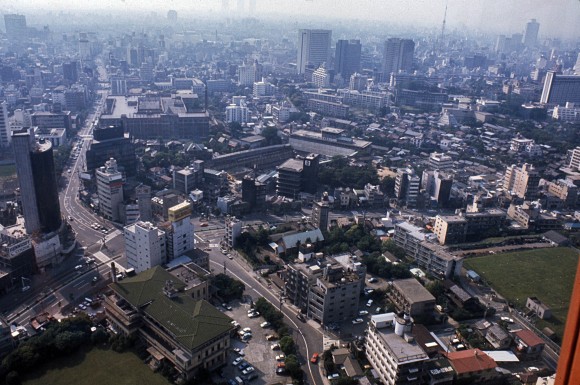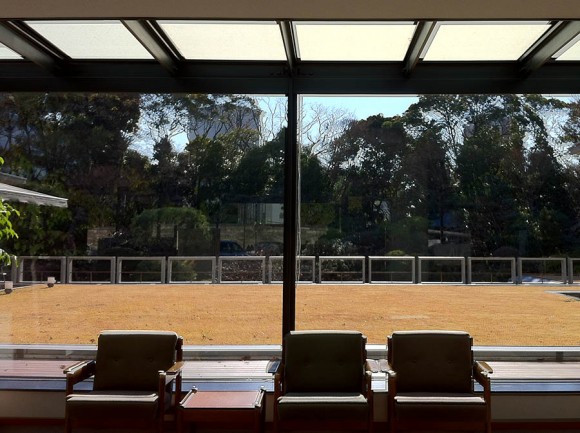Owing to the popularity of my post from the other day I thought I’d assemble some more “Tokyo: before and after” shots. What follows are images that illustrate how Marunouchi has been transformed over the decades. Another example, my personal favourite, shows the area east of Shinagawa.
Category Archives: Tokyo
Tokyo Tower Views
The built context of most Tokyo buildings shown on this blog has been radically transformed since their completion several decades ago. It is now almost strange to see these architectural icons stand in their “native” setting or while they were under construction. Thanks to Flickr and Tokyo Tower, we can even have a look further back. 1 December 2013: Update now at bottom of post, 23 February 2014: Another shot at bottom of the post.
Both NOA Building and Reiyukai Shakaden under construction May 1974, photo posted with permission from Flickr user CosmicShip
International House Japan
The International House Japan carries a special place in Japan’s post-war architectural history. Here, Tange would host several weddings for members of his Tange Lab, including Kurokawa’s. In 1960, the Metabolists would also use the building to write their founding document.
Architecture of Affluence
I picked up the great “Architects of Affluence: The Tsutumi Family and the Seibu Enterprises in 20th-Century Japan” the other day. It’s a fascinating monograph written about 20 years ago by Thomas Havens. It helped me connect the dots between railroad, (sub-)urbanisation and the onset of mass consumerism in post-war Japan. Can an architectural dimension be woven into this? Let’s visit Shibuya!
Book update / chapter ideas
As the book project on Tokyo’s architecture takes up a lot of my time, I thought I’d post an update on where we stand. There are also a few new chapter ideas I wanted to brainstorm – and what place better for that than my blog.
 Sakuradai Village, photo by Manuel Oka
Sakuradai Village, photo by Manuel Oka
New Tumblr
I’ve been doing a fair bit of research in connection with the book project I’m working on. Trying to find footage (both still and video) from post-war Japan (which for the convenience of the project is loosely defined as the first three decades after 1945) has become a bit of a hobby along the way. Instead of posting too much of this on this blog, I have decided to put all these little snippets up on a new Tumblr called “1945-1975 Japan”, to be found at postwarjapan.tumblr.com. Enjoy!
Flying to Japan
We sometimes take for granted how easy it is to fly across the world. The jet-engine revolution in civil aviation of the 1950s cut distances short considerably. I stumbled upon a few timetables from the 1950s and 60s which really drive that point home.
Tokyo Olympics continued
While researching for my book chapter, I just stumbled upon this amazing simplified map of Tokyo. It appeared in Sports Illustrated in 1964, and shows all the venues and points of interest for the visitor to the Summer Olympics, which took place here in October. You can access by clicking on “view this issue” (or try this link instead and go to pages 44/45). See below for a screenshot (click to magnify).
Several of the buildings on the map will be discussed in the upcoming book: Hotel Okura, Yoyogi National Gymnasium as well as Komazawa Olympic Park with its great stadiums. I wrote up a few facts on the Games here.
The photos preceding the map are gorgeous and the American tourism guide immediately after the map is worth the (cumbersome) read as well. From cheap taxis, road naming conventions, long nights followed by a Tsukiji fish market experience to buildings to be avoided for their apparent ugliness (Diet building, Tokyo Tower), the article is a great reminder of what has and what hasn’t changed since fifty years ago.
Book project update
It’s been a while that I wrote about my book project on some of Tokyo’s iconic 60s/70s buildings. Work has been ongoing over the last couple of months and the project has been growing in scope and depth. There is now four confirmed chapters written by four different authors. Architectural photographer Manuel Oka has started taking shots of the buildings. Here are some of his photos:
Danchi
A friend of a friend is a researcher on Japanese public housing projects. Their history is inextricably linked to Japan’s economic miracle from the 1950s onwards. When researching the book, I thought that the chapter on urbanisation would benefit greatly from an inset about danchi.








